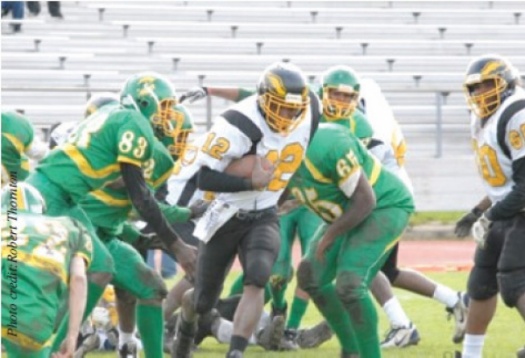
Dyett High School had a successful 2009 football campaign. They went 8-2 overall and were undefeated in conference play, toppling conference foe Senn 14-6 in the last game of the season to win the Great Lakes Conference.
Dyett High School had a successful 2009 football campaign. They went 8-2 overall and were undefeated in conference play, toppling conference foe Senn 14-6 in the last game of the season to win the Great Lakes Conference.
Winning the conference paid big dividends for the Dyett Eagles, and they’ll move up to the more competitive Illini Conference next season.
After the regular season Dyett lost in the first round of the playoffs to downstate Herscher 32-6. They were not alone in losing in the first round, as the majority of Public League football teams made an early exit from post-season play.
Now that the season is over, coaches and players have time to reflect and figure out what they can do to advance deeper into the state playoffs next year, and begin to compete on a higher level against suburban and downstate football programs.
At Dyett, Head Coach John Terry had his team play the first game of the 2009 season against 7A power Rolling Meadows on the road. The odds of winning that game were not in their favor and they lost 48-0, but the experience of playing a topnotch opponent got his team geared up for the rest of the season.
“My boys had never seen anything like that. The Public League doesn’t show you anything like that,” Terry said. “But I wanted them to be prepared for state and playing the top competition would prepare them.”
“They saw what they had to do and stepped it up. They had more fire after that game,” he added.
That fire and competitive spirit propelled Dyett through the regular season, but it was the playoffs, and future playoffs that pose the biggest obstacle to the ultimate goal of a state title.
Suburban and downstate teams often have a marked advantage in several areas that are key to developing long-term success on the gridiron.
One advantage is the number of players they field. Many schools, including the more successful public league schools like Morgan Park and Simeon, have 50 or more players dress for each game, while schools like Dyett and Senn are more likely to suit up about 25 players.
This small number of available bodies causes problems in practice and at game time. It means that most of the players have to play on offense and defense.
They are young men and have plenty of stamina, but it begins to wear them down, especially against teams that have their key players specialize in one area and get some rest while the rest of the team goes to work.
But don’t tell the rugged Dyett players that they’re at a disadvantage. Jamal Walls plays running back and linebacker for the Eagles and he wouldn’t have it any other way.
“I work hard in practice and work out by myself, said the senior player, who rushed for 1123 yards and 15 TD’s. “I’ve been playing football since third grade so my body’s immune to it. I like hitting people and I like running over people. If I get to do both in college I’ll like it.”
But many athletes who might try out for football don’t look forward to the hitting and contact that Walls’enjoys.
“Some kids don’t like the physicality of the sport or the long-term commitment,” said Senn head coach Lewis-Bey.
Lewis-Bey also thinks that kids and society have changed over the years in a way that isn’t conducive to them playing a game like football.
“It’s not a video game, this is real. You can’t press reset, and if you make a mistake you can’t press pause,” he said
Another problem is the lack of training equipment such as blocking sleds, tackling dummies and even quality footballs. With limited equipment the players have to battle and tackle each other in practice more than they would like and this leads to injuries.
Coach Terry laments the lack of equipment, but points out that football is a “gladiator sport” and the “hand-to-hand combat” practices help prepare his team for battle during actual games. But there is one thing that he’s tired of doing without, and that is a quality weight training facility. Currently they only have about 250 pounds of weights available.
“We’ve been doing it with smoke and mirrors so far,” Terry said. “We need sleds, new uniforms and other equipment, but we need that weight room most of all.”
Lastly, the problem of parent and fan participation is an issue at football games. The stands are mostly empty, even for winning teams like Senn and Dyett. And the lack of interest doesn’t sit particularly well with Terry.
“I just think the parents should come out to the games and we should have more fans. Just to congratulate these kids so they don’t want to go back to the streets,” he said.
Sadly, Dyett High School has already lost two students to violence this school year. On Oct. 27 Martel Barrett was shot and killed.
A few weeks prior to that Corey Harris, a standout athlete on the basketball and baseball teams was gunned down.
Terry had approached Harris about playing football, but he wasn’t into it.
He wonders now if football might have saved Harris’ life that day, especially because they were away playing in the third game of the season at roughly the same time Harris was shot.
“Two kids died from this school. I’m not saying that if they were in sports they would have stayed alive, but maybe I can say that,” said Terry. “If they were in any extracurricular activities, even if it was band or badminton it doesn’t matter, it would have kept them off the street.”